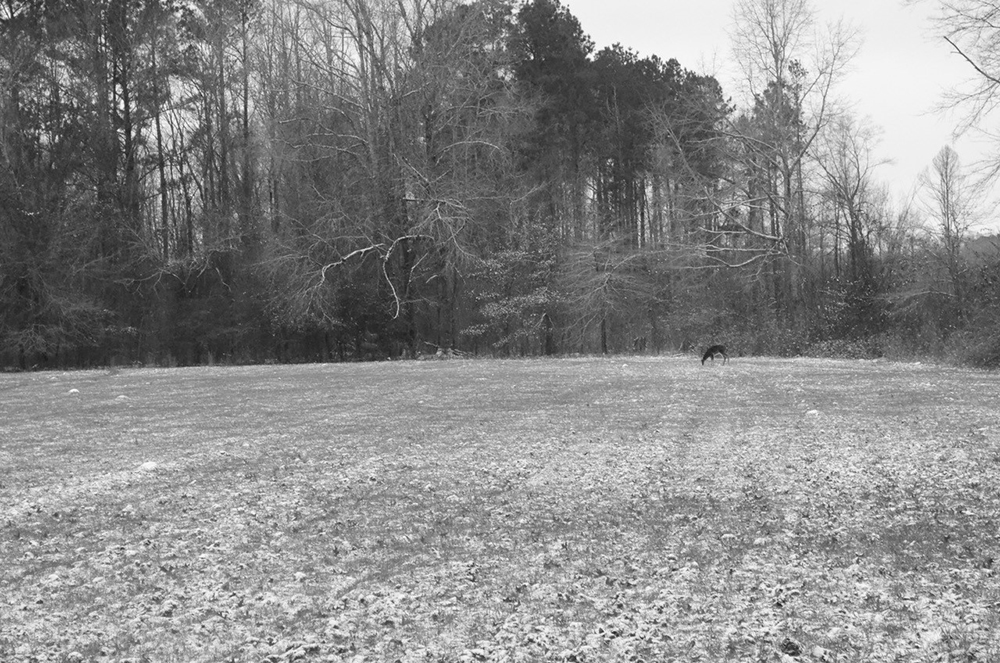
by Terry Wieland
Sitting in a deer stand, when there are no deer in sight, haven’t been for two hours, and are unlikely to be for the next hour because it’s pouring rain and your el cheapo poncho has sprung several leaks, is not a lot of fun. It can, however, be educational.
In early January, I was at Westervelt in Alabama, occupying just such a deer stand, on just such an afternoon. It was cold, wet, miserable. The high, four-legged metal stand with its old swivel seat was situated in the midst of tall pines and long grass, with muddy avenues cut to accommodate quail hunters. To the front, it looked out across a logged-over mess, 600 yards to the far timber; off to the right, screened by brush, was a small food plot; behind, through the pines, was a ravine.
It was a stand where anything could happen, from sniping at a third of a mile, to a running deer at my feet, to a Hail Mary! through thick brush. The food plot was 150 yards away and, for lack of anything better to look at, I watched it. I’d climbed into the stand just after two o’clock, hauling rifle and pack up the icy steel rungs, evading the tattered burlap skirt that hung like a curtain, and managed to get myself situated without serious injury.
Darkness would come around six. It was raining when I got myself situated, and continued to pour for the next two hours, during which time nothing happened. Nothing at all. Along about four-thirty the rain eased. A doe stepped daintily out into the food plot from the far edge, and began nibbling her way toward the middle. I watched, periodically swiveling the seat to look at the ravine behind me, the long grass through the pines down to my right, and the thick brush screening the track to my left. Typical deer-stand activity, all done in slow motion so as not to attract attention.
Suddenly, in mid-swivel, three deer appeared in the grass. Two does and a young buck, bounding from behind me, toward the food plot. The young ladies were just having fun, but the buck was unsure which one he wanted to chase, so he was chasing neither. When he caught sight of the lone doe in the food plot, he decided she might like to talk to him and headed off thataway.
I kept my eye on the spot where they’d come from. A few minutes later, another buck appeared, this one a forkhorn, and obviously no fool. First his head eased out from behind a tree, then he looked straight up at the stand where I was sitting. We both froze. After a minute or two, he took another few steps, stopped, and looked again.
This performance continued as he crept toward the food plot a hundred yards away, never taking his eyes off the stand for long. He reached the plot, saw nothing of interest, and turned to come back, but still he watched me. Fortunately, my shape was broken up by the poncho, but he was still suspicious. Obviously, he had been a witness, this year or last, to a hunter in the stand either knocking off one of his pals, or attempting to. And he was taking no chances.
Deer are not fools. I’ve had similar experiences, although never so obvious, in other stands which have occupied the same spot, year after year. Familiar they may be — that’s the usual argument — but so is their empty silhouette. Change that silhouette by parking a hunter in the seat, and the animals are immediately aware of it.
That forkhorn skirted my stand for the better part of an hour, as darkness fell and the rain stopped for good, replaced by a chilly wind that made the tattered burlap skirts flap. He was aware of every change, every nuance of movement. As shooting light departed and I rose to do the same, his head came up with a jerk and he was away into the brush with a long bound and a wave of his white tail.
I didn’t get a deer that day, but I did further my education.
——————————————————————————————————————–
Terry Wieland has been Shooting Editor of Gray’s since 1993 and is the author of a dozen books on hunting, shooting, and history. His latest is Great Hunting Rifles — Victorian to the Present, published by Skyhorse in 1997. Last year, Skyhorse reprinted his acclaimed 1999 book on Robert Ruark, A View From A Tall Hill.
